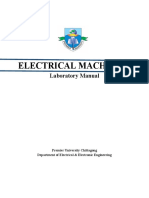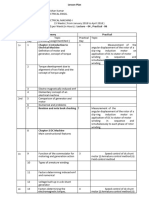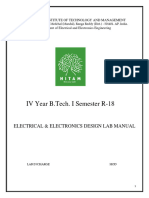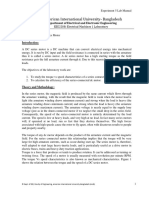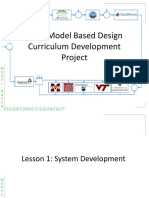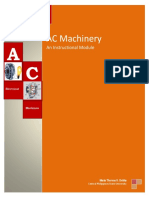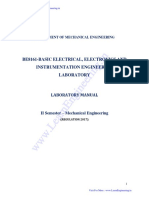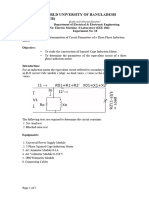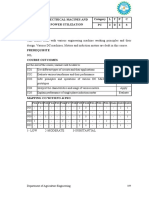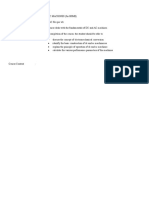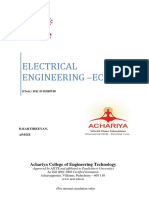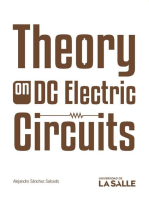Electrical Machinery Manual
Electrical Machinery Manual
Uploaded by
Haroon JehangirCopyright:
Available Formats
Electrical Machinery Manual
Electrical Machinery Manual
Uploaded by
Haroon JehangirCopyright
Available Formats
Share this document
Did you find this document useful?
Is this content inappropriate?
Copyright:
Available Formats
Electrical Machinery Manual
Electrical Machinery Manual
Uploaded by
Haroon JehangirCopyright:
Available Formats
Name
Reg. No.
Fall 2024
MCT-223L ELECTRICAL MACHINERY
UNIVERSITY OF ENGINEERING AND TECHNOLOGY LAHORE,
FAISALABAD CAMPUS.
MCT-221L ELECTRICAL MACHINERY LAB MANUAL
LIST OF EXPERIMENTS
Experiment EXPERIMENT TITLE Page
No. No.
1 DC Machine Winding Resistance: 3
Objectives:
1. Find the ohmic resistance of the exciter winding in a DC motor.
2. Find the ohmic resistance of armature winding.
2 DC Shunt Motor: 6
Objectives:
1. Study & analyze the connection and operation of Shunt wound.
2. Speed measurement of shunt wound motor.
3 DC Series & Compound Motor: 10
Objectives:
1. Analyze connection & operation of series wound motor.
2. Analyze connection & operation of compound wound motor.
4 Controlling of DC Machine: 14
Objectives:
1. Speed control by adding resistance in armature circuit.
2. Speed control via changing armature & exciter voltage.
3. DC motor direction Control.
5 DC Motor Braking: 21
Objective:
To study Rheostatic Braking.
6 Slip ring Machine with shorted &unconnected rotor winding: 25
Objectives:
1. Slip ring machines with unconnected rotor windings.
2. Slip ring machines with shorted rotor windings.
3. Voltage at rotor for unconnected rotor winding.
7 Slip Ring Machines with starting resistors: 33
Objectives:
1. Slip ring machines with starting resistors.
2. Measurements of voltage on stator and rotor.
8 Stepping Motor in full step mode: 37
Objectives:
1. Step angle & steps/revolution calculation in full step mode.
2. Determine the step angle in full step mode.
3. Determine the maximum frequency in full step mode.
9 Stepping Motor in Full Step Mode: 43
Objectives:
1. Find maximum start frequency in full step mode.
2. Control signals in full step mode.
3. Direction control of stepping motor in full step mode.
10 Stepping Motor in Half Step Mode: 48
Objective:
1. Control signals in half step mode.
Department of Mechanical, Mechatronics & Manufacturing Engineering Page 1
MCT-221L ELECTRICAL MACHINERY LAB MANUAL
11 Linear Motor: 51
Objective:
Measure the induced voltage in linear motor.
12 Motor Constant for Linear Motor: 59
Objective:
Find Motor constant of Linear motor.
13 3 Phase Linear Motor: 63
Objectives:
1. Measurement of induced voltage - slow movement.
2. Linear motor with three phase variable voltage.
3. Linear motor with variable 3 phase frequency.
14 BLDC Motor: 70
Objectives:
1. Cogging Torque.
2. Switching States.
Department of Mechanical, Mechatronics & Manufacturing Engineering Page 2
MCT-221L ELECTRICAL MACHINERY LAB MANUAL
Name
Reg. #
Marks
EXPERIMENT # 1
Exciter and Armature winding resistance
Objectives:
1. Find the ohmic resistance of the exciter winding in a DC Motor
Apparatus:
1. DC motor card
2. Lucas-Nulle unitrain module
3. PC
4. Connecting wires
Theory:
A brushed DC motor is an internally commutated electric motor
designed to be run from a direct current power source. When a current pass
through the coil wound around a soft iron core, the side of the positive pole is acted
upon by an upwards force, while the other side is acted upon by a downward force.
According to Fleming's left hand rule, the forces cause a turning effect on the coil,
making it rotate. To make the motor rotate in a constant direction, "direct current"
commutators make the current reverse in direction every half a cycle (in a two-pole
motor) thus causing the motor to continue to rotate in the same direction.
Department of Mechanical, Mechatronics & Manufacturing Engineering Page 3
MCT-221L ELECTRICAL MACHINERY LAB MANUAL
Procedure:
1. Set up the experiment as shown in the figure 1.1.
2. Connect the first exciter winding to the 5V experiment voltage via the 0.47
W shunt located on the experiment card and measure the current (voltage
across the shunt) and the voltage across the exciter winding.
3. Open the virtual instrument Voltmeter A from the menu Instruments /
Measuring Devices. Use the voltmeter A to measure the voltage at the
winding.
4. DC voltages and currents are measured as average value. Now adjust the
parameters on the measuring instrument yourself.
5. Open the virtual instrument Ammeter B from the Instruments / Measuring
Devices menu. Use Ammeter B to measure the winding current flowing
through the 0.47 W shunt.
6. Now adjust the parameters of the meter yourself.
7. Enter the measured values in observations table.
8. Repeat the measurement for the second exciter winding. Connect this
winding up yourself.
9. Enter results in observations.
Circuit Diagram:
Chanel B
+
V
Shunt
5V
-
Chanel A
Excitation
+
V
Fig. 1.1 Circuit arrangement
Department of Mechanical, Mechatronics & Manufacturing Engineering Page 4
MCT-221L ELECTRICAL MACHINERY LAB MANUAL
Observations:
Readings Voltage(v) Current(A) Impedance(R=V/I)
1st exciter winding
2nd exciter winding
Lab Exercises:
Task 1.1: Repeat the measurement for the combined resistance of exciter winding.
Connect this winding up yourself.
Conclusions: Write your observations and comments in the space provided below:
Department of Mechanical, Mechatronics & Manufacturing Engineering Page 5
MCT-221L ELECTRICAL MACHINERY LAB MANUAL
Name
Reg. #
Marks
EXPERIMENT # 2
Shunt Wound DC Motor
Objectives:
1. Connection and operation Shunt wound motor.
2. Speed measurement of shunt wound DC motor.
Apparatus:
1. DC motor card
2. Lucas-Nulle unitrain module
3. PC
4. Connecting wires
Theory:
Shunt wound is a type of dc motor in which both exciter and
armature windings are separately excited. This motor is mostly used for constant
speed applications as speed slightly varies with change in torque.
i) Connection & Operation
Procedure:
1. In this experiment the DC machine is operated as a shunt-wound machine
(separately excited).
2. Set up the apparatus as shown in the fig 2.1 shunt wound arrangement. The
shaft of the rotor is inserted into the bearing situated in the stator. When
attaching the rotor make sure that the attachment pin is inserted into the
socket labeled 0°.
Department of Mechanical, Mechatronics & Manufacturing Engineering Page 6
MCT-221L ELECTRICAL MACHINERY LAB MANUAL
3. Now open the DC Motor Control virtual instrument from
INSTRUMENTS/MOTOR CONTROLS menu. Set this instrument to 12.0
Volts.
4. Switch on the POWER button of the power supply.
Circuit Diagram:
Fig 2.1 Circuit Arrangement for shunt wound machine
Conclusions: Describe your observations and comments in space below.
Department of Mechanical, Mechatronics & Manufacturing Engineering Page 7
MCT-221L ELECTRICAL MACHINERY LAB MANUAL
ii) Speed Measurement:
Procedure:
1. In this experiment we will perform a contactless measurement of the rotation
speed of a DC shunt-wound machine using a stroboscope.
2. The previous experiment set-up of fig 2.1 is retained. It is supplemented
with the stroboscope, which illuminates the rotor with a flash of light but
does not make physical contact with it. Stroboscope is connected at analogue
output socket.
3. Now open the virtual instrument DC Motor Supply from the
INSTRUMENTS/MOTOR CONTROL menu. Set it to 12.0 V. Then switch
the POWER button on.
4. Now go to the INSTRUMENTS menu & open Stroboscope virtual
instrument. Set the flash rate to 30 Hz. Switch the stroboscopes POWER
button on.
5. Point the flash bulb at the rotating armature.
6. Slowly increase the flash rate until you can see the motion appear to stand
quite still.
Observations:
Note the flash rate at which motor appears still and also write down the
corresponding speed for this flash rate.
Read off the speed: __________RPM
Flash Rate: ___________Hz
Department of Mechanical, Mechatronics & Manufacturing Engineering Page 8
MCT-221L ELECTRICAL MACHINERY LAB MANUAL
Lab Exercise:
Task 2.1: Try to find out whether the motion also appears stationary at half or
double the frequency and also describe its reason.
Conclusions: Describe your observations and comments in space below.
Department of Mechanical, Mechatronics & Manufacturing Engineering Page 9
MCT-221L ELECTRICAL MACHINERY LAB MANUAL
Name
Reg. #
Marks
EXPERIMENT # 3
Series & Compound Wound DC Motor
Objectives:
1. Analyze connection & operation of series-wound motor.
2. Analyze connection & operation of compound wound motor
Apparatus:
1. DC motor card
2. Lucas-Nulle unitrain module
3. PC
4. Connecting wires
Theory:
DC Series motor is a type of DC motor in which both shunt and
exciter windings are connected in series while compound motor is another type
which have the characteristics of both series and shunt wound machines.
i. Series Wound Machine:
Procedure:
1. In this experiment the DC machine is operated as a series -wound machine.
2. Set up the apparatus as shown in the fig 3.1. The shaft of the rotor is inserted
into the bearing situated in the stator. When attaching the rotor make sure
that the attachment pin is inserted into the socket labeled 0°.
3. Now open the DC Motor Control virtual instrument from
INSTRUMENTS/MOTOR CONTROLS menu. Set this instrument to 18.0
V. Switch on the POWER button of the power supply.
4. Connect stroboscope and find out motor speed in this configuration.
Department of Mechanical, Mechatronics & Manufacturing Engineering Page 10
MCT-221L ELECTRICAL MACHINERY LAB MANUAL
Circuit Diagram:
Fig 3.1 Circuit Arrangement for Series Wound
Observations:
Applied Voltage: ________Volts
Flash Rate: _____________Hz
Speed: ________________RPM
Conclusions: Describe your observations and comments in the space provided.
Department of Mechanical, Mechatronics & Manufacturing Engineering Page 11
MCT-221L ELECTRICAL MACHINERY LAB MANUAL
ii. Compound Wound Machine:
Procedure:
1. In this experiment the DC machine is operated as a compound-wound
machine.
2. Set up the apparatus as shown in the fig 3.2. The shaft of the rotor is inserted
into the bearing situated in the stator. When attaching the rotor make sure
that the attachment pin is inserted into the socket labelled 0°.
3. Now open the DC Motor Control virtual instrument from
INSTRUMENTS/MOTOR CONTROLS menu. Set this instrument to 18.0
V. Switch on the POWER button of the power supply.
4. Connect stroboscope and find out motor speed in this configuration.
Circuit Diagram:
Fig 3.2 Circuit Arrangement for Compound Wound
Observations:
Applied Voltage: ________Volts
Flash Rate: _____________Hz
Speed: ________________RPM
Department of Mechanical, Mechatronics & Manufacturing Engineering Page 12
MCT-221L ELECTRICAL MACHINERY LAB MANUAL
Lab Exercise:
Task 3.1: Make a speed comparison between shunt wound, compound wound and
series-wound machines.
Conclusions: Describe your observations and comments in the space provided.
Department of Mechanical, Mechatronics & Manufacturing Engineering Page 13
MCT-221L ELECTRICAL MACHINERY LAB MANUAL
Name
Reg. #
Marks
EXPERIMENT # 4
Control of DC Motor
Objectives:
1. Speed control via adding resistance in armature circuit
2. Speed control via changing armature & exciter voltage
3. DC motor direction Control
Apparatus:
1. DC motor card
2. Lucas-Nulle unitrain module
3. PC
4. Connecting wires
Theory:
DC machines can be controlled via different ways. In this lab we will
control direction and speed of DC motor. Firstly, we are controlling speed via
adding a resistor in armature voltage which will in turn change the armature
current and finally this current reduction will change the speed. Secondly, we are
varying the armature and exciter voltage. Varying exciter voltage will change the
magnetic field strength which results in change of Lorentz force and ultimately in
speed variation.
In motor operating mode the direction of rotation can be reversed
either by reversing the poles of the armature voltage or by reversing the poles of
the exciter voltage. Both methods lead to the same result
Department of Mechanical, Mechatronics & Manufacturing Engineering Page 14
MCT-221L ELECTRICAL MACHINERY LAB MANUAL
I. Series resistance in the armature:
Procedure:
1. In this experiment we will investigate the influence of armature series
resistance on the rotation speed of a DC shunt-wound machine.
2. Set up the experiment as shown in the fig 4.1. The shaft of the rotor is
inserted into the bearing situated in the stator. When attaching the rotor bear
in mind that the attachment pin is inserted into the socket labeled 0°.
3. Now open the DC Motor Supply virtual instrument from the
INSTRUMENTS/MOTOR CONTROLS menu.
4. Set the amplitude to an initial level of 15 V. Switch the POWER button of
the power supply ON.
5. Attach Stroboscope and find out the speed with attached resistance
configuration.
Circuit Diagram:
Fig 4.1 Series resistance with armature winding
Department of Mechanical, Mechatronics & Manufacturing Engineering Page 15
MCT-221L ELECTRICAL MACHINERY LAB MANUAL
Observations:
Applied Voltage: ________Volts
Flash Rate: _____________Hz
Speed: ________________RPM
Lab Exercise:
Task 4.1: Now use a short cable to shunt the resistor R6 and disconnect it again
after several seconds. What effects does the armature resistor have on the speed?
Conclusions: Describe your observations and comments in the space provided.
II. Control via changing armature & exciter voltage:
Procedure:
1. In this experiment we will measure the influence of the armature voltage
on the rotation speed of a DC shunt-wound machine.
2. A contactless measurement of the rotation speed will be performed using
the stroboscope.
3. Connect the machine in shunt wound configuration fig 4.2.
4. The shaft of the rotor is inserted into the bearing situated in the stator.
When attaching the rotor make sure that the attachment pin is inserted
into the socket labeled 0°.
5. Now open the DC Motor Supply virtual instrument from the
INSTRUMENTS/MOTOR CONTROL menu. Set the amplitude to an
initial value of 20 V. Switch the POWER button of the power supply ON.
6. Now open the Stroboscope virtual instrument from the INSTRUMENTS
menu.
7. Set the flash rate for the first measurement to the initial value of 100 Hz
and then reduce this gradually until the motion appears to be
stationary. Switch the POWER button of the stroboscope ON.
Department of Mechanical, Mechatronics & Manufacturing Engineering Page 16
MCT-221L ELECTRICAL MACHINERY LAB MANUAL
8. Point the strobe at the rotating armature and use the standard methods to
perform the speed measurements using the values of the armature voltage
specified in the table:
9. Find out speed at different values of armature and exciter voltage and
place in table.
10.Repeat the same experiment to measure the influence of the exciter
voltage on the rotation speed of a DC shunt-wound machine.
11.The procedure is same just replace fixed supply of field winding with
variable supply of armature winding. Now open the DC Motor Supply
virtual instrument from the INSTRUMENTS/MOTOR CONTROLS
menu. Set the amplitude to an initial value of 15 V. Switch the POWER
button of the power supply ON.
12.Now open the Stroboscope virtual instrument from the INSTRUMENTS
menu. Set the flash rate to 30 Hz. Switch the stroboscope's POWER
button ON.
13.Point the strobe at the rotating armature and use the standard method to
measure the speed using the values of the armature voltage specified in
the table.
Circuit Diagram:
Fig 4.2 Circuit Arrangement for shunt wound machine
Department of Mechanical, Mechatronics & Manufacturing Engineering Page 17
MCT-221L ELECTRICAL MACHINERY LAB MANUAL
Observations:
Va (volts) N(rpm) Ve (Volts) N(rpm)
20 15
18 13
16 11
14 9
12 7
10 5
08 3
Lab Exercises:
Task 4.2: Draw a graph between armature voltage and speed and append it on the
page & also describe relationship of armature voltage with speed.
Task 4.3: Draw a graph between exciter voltage and speed and append it on the
page. & also describe relationship of exciter voltage with speed.
Task 4.4: Describe relationship of armature voltage & exciter voltage with rotation
speed in the space given below.
Conclusions: Describe your observations and comments in the space below.
III. Reversing rotation direction:
Procedure:
1. In this experiment we will be exploring the possibilities of reversing the
direction of rotation of a DC shunt-wound machine.
2. Set up the motor in shunt wound configuration as in fig 4.2. The rotor shaft
is inserted into the bearing situated in the stator. When attaching the rotor
make sure that the attachment pin is inserted into the socket labelled 0°.
Department of Mechanical, Mechatronics & Manufacturing Engineering Page 18
MCT-221L ELECTRICAL MACHINERY LAB MANUAL
3. Now open the DC Motor Supply virtual instrument from the
INSTRUMENTS/MOTOR CONTROLS menu. Set the voltage to 12.0 V.
Switch the POWER button of the power supply ON.
4. Observe the direction of rotation of the machine using different power
supply configurations and then check the appropriate check boxes. To
"change" a connection simply interchange the two connections of the exciter
or armature winding.
Observations:
Connection of the windings Rotation direction of the machine
Armature winding unchanged
Clockwise
Exciter winding unchanged
Anti-clockwise
Armature winding changed
Clockwise
Exciter winding unchanged
Counterclockwise
Armature winding unchanged
Clockwise
Exciter winding changed
Anti-clockwise
Armature winding changed
Clockwise
Exciter winding changed
Anti-clockwise
Department of Mechanical, Mechatronics & Manufacturing Engineering Page 19
MCT-221L ELECTRICAL MACHINERY LAB MANUAL
Lab Exercise:
Task 4.5: Explain why an increase in rotation speed in response to field weakening
does not occur as expected with this machine
Conclusions: Describe your observations and comments in space given below.
Department of Mechanical, Mechatronics & Manufacturing Engineering Page 20
MCT-221L ELECTRICAL MACHINERY LAB MANUAL
Name
Reg. #
Marks
EXPERIMENT # 5
DC Motor Braking
Objective:
To study rheostatic braking
Apparatus:
1. DC motor card
2. Lucas-Nulle unitrain module
3. PC
4. Connecting wires
Theory:
Rheostatic braking is primarily used to shutdown drives. This is achieved by
disconnecting the armature from the mains (using switch S1) and connecting an
external resistance RV using switch S2 shown in figure 5.1. The armature current
and the torque reverse their polarity (generator operation). The braking energy is
converted into heat in the resistors. If we don’t add an external resistance, then on
shutting off the mains current will be dissipated within the windings which are
termed as run down in this experiment.
Procedure:
1. Connect the experiment as shown in fig 5.1.
2. Open the Oscilloscope virtual instrument from the Instruments/Measuring
Devices menu.
3. In addition to the connections shown in the figure:
i. Connect channel A to the armature voltage.
ii. Connect channel B to the armature current (voltage across the shunt).
4. Make the following settings: Channel A: 5V/DIV, DC, Channel B: 500mV,
DC, Time base: 200 ms, Trigger: Channel A, pre-trigger 25%, trigger level
approx. 13 V, falling edge Single
Department of Mechanical, Mechatronics & Manufacturing Engineering Page 21
MCT-221L ELECTRICAL MACHINERY LAB MANUAL
5. Activate the trigger before each new measurement by clicking the STOP
button (the green lamp goes out and the trace starts running)
6. Now open the DC Motor Supply virtual instrument from the
INSTRUMENTS/MOTORCONTROLS menu. Set the unit to 20 V. Switch
the POWER button of the power supply ON.
7. After switching on supply motor will start working as shunt wound dc
motor.
8. Now open the switch S1 & close switch S2 motor will become generator
and polarity of armature current will be reversed and CURRENT will
dissipate through Rv and motor will stop moving. Also note down the time
in which motor reaches a stand still.
9. To proceed with the experiment first go to the page titled "Experiment: Run
down" and observe how long it takes for the rotor to reach a standstill on
the oscilloscope. Make sure that the oscilloscope is trigger ready before
turning the page.
10.In conclusion return to this page. Wait until the machine has run up and
reestablish the trigger readiness. Now jump to the page titled "Experiment:
Braking".
Circuit Diagram:
Fig 5.1 Rheostatic Braking
Department of Mechanical, Mechatronics & Manufacturing Engineering Page 22
MCT-221L ELECTRICAL MACHINERY LAB MANUAL
Observations:
Run down:
Braking:
Department of Mechanical, Mechatronics & Manufacturing Engineering Page 23
MCT-221L ELECTRICAL MACHINERY LAB MANUAL
Lab Exercises:
Task 5.1: Find the stand still time for both run down and braking
Conclusions: Write your observations and comments in the space given.
Task 5.2: Compare the stand still time for both run down and braking. Is there a
difference and if so, why is this so?
Conclusions: Write your observations and comments in the space given.
Department of Mechanical, Mechatronics & Manufacturing Engineering Page 24
MCT-221L ELECTRICAL MACHINERY LAB MANUAL
Name
Reg. #
Marks
EXPERIMENT # 6
Slip Ring with Shorted & Unconnected Rotor Winding
Objectives:
1. Slip ring machines with unconnected rotor windings
2. Slip ring machines with shorted rotor windings.
3. Voltage at rotor for unconnected rotor winding.
Apparatus:
1. Slip ring machine card
2. Lucas-Nulle unitrain module
3. PC
4. Connecting wires
Theory:
6.1: Induction Motor Types
1. Squirrel-cage 2. Slip Ring
In induction machines a distinction is drawn between machines with squirrel-cage
rotors and those with slip-ring rotors. In terms of physical response and in the
design of the stator, slip-ring rotor machines do not differ in any way from
squirrel-cage.
However it is the rotors of the machines which are different, having considerable
dissimilarities in their construction.
Department of Mechanical, Mechatronics & Manufacturing Engineering Page 25
MCT-221L ELECTRICAL MACHINERY LAB MANUAL
6.2: Principal differences between slip-ring rotor and squirrel-cage machines
A squirrel-cage rotor (left) has a winding in the form of individual rods, which are
connected at both ends via short-circuit rings. There is no other way to access the
rotor winding from outside and thus no possibility of influencing the rotor's
operating response as shown in figure 6.1. A slip-ring rotor, like its stator, is
equipped with a "real" three-phase winding which is connected in the standard
three-phase star configuration. These windings are represented in the diagram as
three single windings shown in three different colors one color per winding. The
ends of the rotating three-phase windings are connected to the slip-rings, on which
carbon brushes impinge. The terminals of the carbon brushes are connected to
terminal panel. Thus, the rotor winding ends, as well as the ends of the stator
winding, are accessible at the terminal for connection to a circuit. The operating
response of the rotor can be modified as a function of and in accordance with the
circuit configuration.
Fig 6.1 Induction Motor Types
Normally the rotor winding is completely short-circuited after run-up using
resistors.
The following holds true for the speed in all induction machines:
Department of Mechanical, Mechatronics & Manufacturing Engineering Page 26
MCT-221L ELECTRICAL MACHINERY LAB MANUAL
where:
p = number of pole pairs
f1 = frequency of the stator voltage being applied
s = slip
It implies that the following means can be used to change the motor's speed:
• Change the number of pole pairs p, e.g. in pole-changing motors
• Change the frequency f1 of the motor's supply voltage
• Modify the slip s by changing the stator voltage
• Modify the slip s by making changes to the rotor
i. Slip ring Machines with Unconnected rotor windings
Procedure:
1. In this experiment the response of the slip-ring rotor machine is
demonstrated with disconnected rotor windings. Set up the apparatus as
shown in figure 6.2.
2. Open the virtual instrument 3-phase Power Supply from the Instruments
Power Supplies menu. Carry out the following settings:
3. U = 11 V
4. f = 50 Hz
5. Press the POWER button
Department of Mechanical, Mechatronics & Manufacturing Engineering Page 27
MCT-221L ELECTRICAL MACHINERY LAB MANUAL
Circuit Diagram:
Fig 6.2 Slip Ring machines with unconnected rotor windings
Observations:
Q. What do you observe?
1. Rotor rotates slowly
2. Rotor does not rotate
3. Rotor s arts rotating
Q. What is the reason for this response?
1. No current can flow due to the disconnected rotor winding. Since no current is
flowing, there can be no torque generated and thus no rotation.
2. The short circuit interferes with the operation
3. Due to the short-circuit current a magnetic field arised which in conjunction
with the external magnetic field generates a torque.
Department of Mechanical, Mechatronics & Manufacturing Engineering Page 28
MCT-221L ELECTRICAL MACHINERY LAB MANUAL
ii. Slip ring Machines with shorted rotor windings:
Procedure:
1. In this experiment the response of the slip-ring rotor machine is
demonstrated with disconnected rotor windings. Set up the apparatus as
shown in figure 6.3.
2. Open the virtual instrument 3-phase Power Supply from the Instruments
Power Supplies menu. Carry out the following settings:
3. U = 11 V
4. f = 50 Hz
5. Press the POWER button
Circuit Diagram:
Fig 6.3 Slip Ring Machine with Shorted rotor windings
Department of Mechanical, Mechatronics & Manufacturing Engineering Page 29
MCT-221L ELECTRICAL MACHINERY LAB MANUAL
Observations:
Q. What do you observe?
1. Rotor rotates slowly
2. Rotor does not rotate
3. Rotor s arts rotating
Q. What is the reason for this response?
1. No current can flow due to the disconnected rotor winding. Since no current is
flowing, there can be no torque generated and thus no rotation.
2.The short circuit interferes with the operation
3. Due to the short-circuit current a magnetic field arised which in conjunction
with the external magnetic field generates a torque.
iii. Voltage at rotor for unconnected rotor winding:
Procedure:
1. In this experiment we measure the no-load voltage of the rotor winding
connected in open circuit and compare it to the stator voltage.
2. Connect the apparatus as shown in fig. 6.4.
3. Open the virtual instrument 3-phase Power Supply from the Instruments
Power Supplies menu. Carry out the following settings: U = 11 V ,f = 50 Hz
4. Press the POWER button
5. Open the virtual instrument Oscilloscope from the Instruments Meters menu.
Carry out the following settings:
6. Channel A: 5 V/DIV, DC
7. Channel B: 10 V, DC
8. Time base: 5 ms
9. Trigger: Channel B
10.Copy the trace into the grid.
Department of Mechanical, Mechatronics & Manufacturing Engineering Page 30
MCT-221L ELECTRICAL MACHINERY LAB MANUAL
Circuit Diagram:
Fig 6.4 Slip ring machine with unconnected rotor winding
Observations:
Copy the trace into grid.
Read off the peak values of both voltages and copy them into the appropriate
Department of Mechanical, Mechatronics & Manufacturing Engineering Page 31
MCT-221L ELECTRICAL MACHINERY LAB MANUAL
boxes!
Channel A: Rotor voltage VKL =
Channel B: Stator voltage V12 =
Lab Exercise:
Task 6.1: Make a comparison between unconnected rotor winding and shorted
rotor winding and also tell the reason for different response.
Conclusions: Describe your Comments in the space given below.
Department of Mechanical, Mechatronics & Manufacturing Engineering Page 32
MCT-221L ELECTRICAL MACHINERY LAB MANUAL
Name
Reg. #
Marks
EXPERIMENT# 7
Slip Ring Machines with Starting Resistors
Objectives:
1. Slip ring machines with starting resistors.
2. Measurements of voltage on stator and rotor.
Apparatus:
1. Slip ring machine card
2. Lucas-Nulle unitrain module
3. PC
4. Connecting wires
Theory:
Slip ring machine along with starting resistors can be easily controlled
via varying the resistor values. Furthermore, these starting resistors help in
increasing starting torque and limiting starting current.
Department of Mechanical, Mechatronics & Manufacturing Engineering Page 33
MCT-221L ELECTRICAL MACHINERY LAB MANUAL
1. Slip ring machines with starting resistors:
Procedure:
In this experiment the no-load voltage of the rotor winding with starter resistors is
measured and compared to the stator voltage. The slip and the rotation speed are
calculated.
1. Connect the circuit as shown in figure 7.1.
2. Open the virtual instrument 3-phase Power Supply from the Instruments
Power Supplies menu. Carry out the following settings: U = 11 V ,f = 50 Hz
3. Press the POWER button
4. Open the virtual instrument Oscilloscope from the Instruments Meters menu.
Carry out the following settings:
5. Channel A: 5 V/DIV, DC
6. Channel B: 10 V, DC
7. Time base: 5 ms
8. Trigger: Channel B
9. Copy the trace into the grid.
Circuit Diagram:
Fig 7.1 Slip Ring Machines with starting Resistors
Department of Mechanical, Mechatronics & Manufacturing Engineering Page 34
MCT-221L ELECTRICAL MACHINERY LAB MANUAL
Observations:
Stator and rotor voltage with starting resistors Copy the trace into the grid.
Read out the peak values of the two voltages
Channel A: Rotor voltage =______V
Channel B: stator voltage U12 =________V
Also read off the period duration of the two voltages and calculate the frequencies
f = 1/T.
Channel A: Frequency of the rotor voltage f2 =
Channel B: Frequency of the stator voltage f1 =
Compute the slip based on the measured frequency values:
s = (f1 - f2) / f1 =
Department of Mechanical, Mechatronics & Manufacturing Engineering Page 35
MCT-221L ELECTRICAL MACHINERY LAB MANUAL
Compute the speed:
n = 60 * f1 * (1 - s) / p = __________rpm
Connect the stroboscope to the BNC socket of
ANALOG OUT.
Open the virtual instrument Stroboscope from the
Instruments menu.
Set it to the speed value calculated above.
Push the POWER button
Now measure the actual rotation speed by increasing or reducing the strobe frequency
step-by-step until you have an image that appears to stand still:
n =_______rpm.
Lab Exercise:
Task 7.1: Compare the speed of short circuited slip ring machine with starting
resistors slip ring machine and describe reason of this difference.
Conclusions: Write your comments in the space provided below
Department of Mechanical, Mechatronics & Manufacturing Engineering Page 36
MCT-221L ELECTRICAL MACHINERY LAB MANUAL
Name
Reg. #
Marks
EXPERIMENT# 8
Stepping Motor in full step mode
Objectives:
1. Step angle & steps/revolution calculation in full step mode.
2. Determine the step angle in full step mode.
3. Determine the maximum frequency in full step mode.
Apparatus:
1. Stepping Motor card
2. Lucas-Nulle unitrain module
3. PC
4. Connecting wires
Theory:
Stepping motor has three types 1. Reluctance 2. Synchronous
3. Hybrid. Hybrid is best among them as it enjoys the advantages of both
reluctance and synchronous. Hybrid is further divided in full step and half step
mode depending upon the control circuitry of stepper motor. In this experiment we
will see the full step mode in detail.
Full-step mode can be divided into "single-phase mode", where
only one phase is under current and "two-phase mode", where there are always
two phases being supplied with current. The differing application of current affects
the corresponding cogging torque and operating torque. Single-phase operation is
seldom used, and we will not investigate it in detail.
The following illustration in fig 8.1 shows the pattern for the current
and the alignment of the stator flux that results for full-step mode in two-phase
operation. Here it is assumed that the two stator windings are supplied with
Department of Mechanical, Mechatronics & Manufacturing Engineering Page 37
MCT-221L ELECTRICAL MACHINERY LAB MANUAL
currents of ISa and ISb. Under such circumstances, the alignment of the stator flux
changes in each case by 90°. The rotor lags behind as a result of the inertia of its
mass and when there is no load, it aligns in the direction of the resultant stator flux.
Fig 8.1 Full Step Mode& Hybrid Stepper Motor
The maximum frequency of a stepper motor specifies the maximum
frequency at which the motor can be operated and still attain each position with
certainty. The maximum frequency is also determined by the load. This means that
as the torque to be applied becomes greater, the maximum frequency becomes
smaller.In the illustration fig 8.2 it can be seen how the torque reduces with
frequency.
Fig 8.2 Torque speed Curve
Department of Mechanical, Mechatronics & Manufacturing Engineering Page 38
MCT-221L ELECTRICAL MACHINERY LAB MANUAL
1) Step Angle & steps/ Revolution Measurement:
Procedure:
1. In this exercise you will determine the step angle of the stepper motor based
on mechanical aspects. The step angle is defined for full-step operation, as
are the other parameters referring to the motor.
2. In permanently excited stepper motors rotor requires as many steps for one
revolution as the stator field does. In full-step mode that comes to 4 steps. If
more poles are added to the motor, so that the poles alternate (each pole
electrically 180° out of phase with the next), then more steps need to be
undertaken to complete a full revolution.
3. In hybrid motors there are 10 north poles and 10 south poles. There are also
2 phase windings that are distributed over 4 windings in total. That means
there are ten times as many poles as there are in the permanently excited
stepper motor. As a result, 10 times as many steps are required for a
revolution. This means the hybrid motor illustrated there needs 40 steps in
full-step mode and 80 steps in half-step mode.
4. This rotor has 100 teeth altogether. That implies 50 north poles and 50 south
poles. Determine from the data provided to you how many steps are required
per revolution.
5. Check your results on the actual motor.
6. Let the motor rotate with a multiple of the calculated steps per revolution. If
the value is correct, the needle will continue to remain in its initial position.
7. Assemble experiment in full step mode as shown in fig 8.3.
8. Open the Stepper Control Unit virtual instrument from the Stepper Motor
sub-menu under Instruments. Configure the settings as in the graphic below.
9. Multiply the number of steps per revolution by 5 and enter this value into the
STEPS field. Multiplying by five exaggerates the effect of any error in the
value.
Department of Mechanical, Mechatronics & Manufacturing Engineering Page 39
MCT-221L ELECTRICAL MACHINERY LAB MANUAL
10.If calculated steps/revolution is correct motor will complete 5 revolutions to
cover these steps
Circuit Diagram:
Fig 8.3 Stepper motor in full step mode
Observations:
The number of steps per revolution is: _____________
Use the following formula to calculate the step angle á. The step angle is the angle
the rotor moves from one step to the next.
The step angle is: _________________
Department of Mechanical, Mechatronics & Manufacturing Engineering Page 40
MCT-221L ELECTRICAL MACHINERY LAB MANUAL
If Steps entered in stepper control unit are following, then tell the revolutions
required by motor.
Steps Revolutions
200
350
700
950
1200
2) Maximum Frequency Measurement:
Procedure:
1. Connect up the stepper motor in full step mode as in previous section.
2. Open the Speed Control virtual instrument from the Instruments menu. Set
it up as follows:
a. STEP MODE: FULL
b. FREQUENCY: 1Hz
c. POWER on
3. Raise the frequency in increments until the rotor gets "out of step".
Observations:
The maximum step frequency for full-step operation with no load is:
___________Hz
Department of Mechanical, Mechatronics & Manufacturing Engineering Page 41
MCT-221L ELECTRICAL MACHINERY LAB MANUAL
Lab Exercise:
Task 8.1: If a stepping motor has 500 teeth altogether then how much steps will be
required by it to complete one revolution in full step and half step mode.
Conclusions: Describe your observations comments in the space provided.
Department of Mechanical, Mechatronics & Manufacturing Engineering Page 42
MCT-221L ELECTRICAL MACHINERY LAB MANUAL
Name
Reg. #
Marks
EXPERIMENT # 9
Stepping Motor in Full step Mode.
Objectives:
1. Find maximum start frequency in full step mode.
2. Control signals in full step mode.
3. Direction control of stepping motor in full step mode
Apparatus:
1. Stepping Motor card
2. Lucas-Nulle unitrain module
3. PC
4. Connecting wires
Theory:
The start frequency of a stepper motor specifies the maximum speed
at which a motor can be initially activated without losing positions. This frequency
also depends on the load connected.
i) Maximum Start Frequency:
Procedure:
1. Connect up the stepper motor in full step mode as in fig 9.1.
2. Open the Speed Control virtual instrument from the Stepper motor sub-menu
under Instruments.
Department of Mechanical, Mechatronics & Manufacturing Engineering Page 43
MCT-221L ELECTRICAL MACHINERY LAB MANUAL
Set it up as follows:
STEP MODE: FULL
FREQUENCY: 300Hz
POWER on
3. If the motor starts rotating, switch it off and increase the frequency.
Determine experimentally in this way the maximum frequency at which the
motor will start rotating.
Circuit Diagram:
Fig 9.1 Stepping motor in full step mode
Observations:
The maximum start frequency as determined by experiment is: _______ Hz
Department of Mechanical, Mechatronics & Manufacturing Engineering Page 44
MCT-221L ELECTRICAL MACHINERY LAB MANUAL
ii) Control Signals in Full step mode:
Procedure:
1. Investigate the control signals for the stepper motor in full-step mode.
2. In order to obtain definitive signals, the current regulation that would
normally take effect is suppressed by two resistors connected in series with
the windings.
3. Connect up the stepper motor as shown in figure 9.1
4. Open the Speed control virtual instrument from the Stepper Motor sub-menu
under Instruments. Set it up as follows:
i. Full-step
ii. Frequency: 100Hz
iii. Direction of rotation: CCW
5. Power on
6. Open the Oscilloscope virtual instrument from the Measuring Instruments
menu. Set it up as follows:
i. Time/div: 20ms
ii. Trigger: Channel A
iii. Channel A: Volts/div: 10; DC coupling
iv. Channel B: Volts/div: 10; DC coupling
7. Shift the zero axes so that both channels are visible.
8. Measure the voltages applied to the windings of the stepper motor. Enter the
signals into observations graph.
Observations:
Department of Mechanical, Mechatronics & Manufacturing Engineering Page 45
MCT-221L ELECTRICAL MACHINERY LAB MANUAL
Q. How do you interpret the signals?
1. The signals are phase-shifted by 180
2. The signals are phase-shifted by 90°
3. The output voltage is a square wave
4. The output frequency is 100 Hz
5. The output frequency is 25 Hz
Q. At what times are steps carried out?
1. on each edge of the motor phase on channel A
2. on each edge of the motor phase on channel B
3. on each edge of the motor phase on both channels
iii) Reversing the Direction:
Procedure:
1. Connect up the stepper motor as shown in fig. 9.1.
2. Open the Speed control virtual instrument from the Stepper Motor sub-menu
under Instruments. Set it up as follows:
i. Full-step
ii. Frequency: 100Hz
iii. Direction of rotation: CW
iv. Power on
3. Open the Oscilloscope virtual instrument from the Measuring Instruments
menu. Set it up as follows:
i. Time/div: 20ms
ii. Trigger: Channel A
iii. Channel A: Volts/div: 10; DC coupling
iv. Channel B: Volts/div: 10; DC coupling
4. Shift the zero axes so that both channels are visible.
5. Measure the voltage applied to the windings. Enter the results into
observations.
Department of Mechanical, Mechatronics & Manufacturing Engineering Page 46
MCT-221L ELECTRICAL MACHINERY LAB MANUAL
Observations:
Q: What is different as opposed to the reverse direction?
1. The amplitude of the voltage is different
2. The frequency is different
3. The phase-shift between the signals is different
Lab Exercise:
Task 9.1: Compare the Maximum step frequency with maximum start frequency in
full step mode.
Conclusions: Describe your observations & comments in space below.
Department of Mechanical, Mechatronics & Manufacturing Engineering Page 47
MCT-221L ELECTRICAL MACHINERY LAB MANUAL
Name
Reg. #
Marks
Experiment # 10
Stepping Motor in Half Step Mode
Objectives:
Control signals in half step mode.
Apparatus:
1. Stepping Motor card
2. Lucas-Nulle unitrain module
3. PC
4. Connecting wires
Theory Reference:
Chapter 10
BOOK: Electric Machinery Fundamentals
Author: Stephen J. Chapman
BOOK: Stepper Motors: Fundamentals, Applications and Design
Author: V. V. Athani
i) Control Signals in Half step mode:
Procedure:
1. Connect up the stepper motor as shown in the animation of supporting
software.
2. Open the Speed control virtual instrument from the Stepper Motor sub-menu
under Instruments.
Set it up as follows:
Department of Mechanical, Mechatronics & Manufacturing Engineering Page 48
MCT-221L ELECTRICAL MACHINERY LAB MANUAL
i. Half-step
ii. Frequency: 100Hz
iii. Direction of rotation: CCW
iv. Power on
3. Open the Oscilloscope virtual instrument from the Measuring Instruments
menu. Set it up as follows:
i. Time/div: 20ms
ii. Trigger: Channel A
iii. Channel A: Volts/div: 10; DC coupling
iv. Channel B: Volts/div: 10; DC coupling
4. Shift the zero axes so that both channels are visible.
5. Measure the voltages applied to the windings of the stepper motor. Enter the
signals into the graph.
Observations:
Department of Mechanical, Mechatronics & Manufacturing Engineering Page 49
MCT-221L ELECTRICAL MACHINERY LAB MANUAL
Lab Exercise:
Task 10.1: Compare the signals in half-step mode with full-step mode.
Conclusions: Write your observations and comments in the space provided below.
Department of Mechanical, Mechatronics & Manufacturing Engineering Page 50
MCT-221L ELECTRICAL MACHINERY LAB MANUAL
Name
Reg. #
Marks
Experiment # 11
Linear Motor
Objectives:
Measure the induced voltage in linear motor.
Apparatus:
1. Linear Motor
2. Lucas-Nulle unitrain module
3. PC
4. Connecting wires
Theory:
11.1: Introduction:
To understand how linear motors work, you must first understand how
rotary electric motors work, because the principle is exactly the same. The motor
shown in the next illustration fig 11.1 consists of a permanent-magnet stator and a
three-phase rotor with coil windings named U, V and W. The interaction between
the magnetic field of the permanent magnets and the current in the coils produces a
force which tends to rotate the rotor.
Fig 11.1 Rotary Electric Motor
Department of Mechanical, Mechatronics & Manufacturing Engineering Page 51
MCT-221L ELECTRICAL MACHINERY LAB MANUAL
By a leap of imagination, this device can be transformed into a linear
motor simply by cutting open and unrolling it. The cylindrical arrangement of the
coils is changed to a flat structure. The same force described above will now
produce linear movement. Therefore, a rotating motor with a rotor and
stator translates to a linear motor with a primary part and a secondary part. The
primary always features the coils and the secondary part has the permanent
magnets. These terms do not necessarily indicate the movable part of a linear
motor as either one can be moved. During this course the primary part is movable.
Fig 11.2 Linear Motor
11.2: Linear motor classification:
The family of electric drives has a huge number of members with
different properties. To get a better understanding of the various motors, we
categories different types in various groups. The motors in a group must have at
least one common property. Two large groups are based on the properties of
"rotary motion" and "linear motion". Therefore, we put all motors that produce
linear motion in the group "linear motors".
Other properties used for classification are:
• Number of phases (typically three)
• Current applied to the coils (direct current or alternating current)
• Type of coupling used to couple the primary with the secondary
o Synchronous = current carrying coils and permanent magnets
o Induction = current carrying coils and induced current
• Ratio of lengths of the primary and the secondary part
o Long stator = the part with the coils is longer than the part
with the permanent magnets (as used in maglev trains)
Department of Mechanical, Mechatronics & Manufacturing Engineering Page 52
MCT-221L ELECTRICAL MACHINERY LAB MANUAL
o Short stator = the part with the coils is shorter than the part
carrying the magnets (as in the motor provided for the course)
11.3: Configuration of Linear Motor:
Linear motors can be implemented in many different ways.
In this course, a planar linear motor with a non-ferrous primary part is used.
11.3.1: Planar linear motor
Fig 11.3 Planar Linear Motor
The ever-present problem of this type of motor is the vertical force
of attraction between the primary and the secondary part. This force of attraction
can be many times bigger than the horizontal propulsive force and must be
compensated for using mechanical guidance (mechanical support) of the movable
part.
11.3.2: Cylindrical (tubular) moving magnet linear motors:
Another type is seen when the plane of the coils and the magnets are
rolled back around an axis. The movement of the motor is oriented along the axis.
Fig 11.4 Cylindrical (tubular) moving magnet linear motors
The primary part is arranged around the cylindrical part of the secondary part. The
primary part thus forms an outer cylinder and the secondary part an inner cylinder.
In another solution, the primary part forms the inner and the secondary part forms
the outer cylinder.
This means that either the primary or the secondary part can be moved.
Department of Mechanical, Mechatronics & Manufacturing Engineering Page 53
MCT-221L ELECTRICAL MACHINERY LAB MANUAL
11.4: Induced Voltage Measurement:
To grasp how electrical machines work, it is important to understand
the interaction between electricity and magnetism. A key result of this interaction
is the induction of a voltage in a wire or a coil. Let us explain the generation of this
induced voltage using the example of linear motor.
The following fig 11.5 shows the magnetic track of a linear
motor. Alternate magnets have different poles facing upwards (north or south),
as shown here in red and blue. When a coil is moved left to right over this
arrangement of magnets, an induced voltage (induced in the coil) can be detected
by a voltmeter. This changes sign depending on the coil's position over the
magnets.
Fig 11.5 Magnetic Track
The primary part of the motor consists of three coils that give rise to
phases U, V and W. The coils or so arranged that the induced voltages in these
coils have a phase difference of 120°. This is fundamental to alternating current
technology.
11.4.1: How the induced voltage is produced:
A voltage is induced when a conductor is moved through a magnetic
field characterized by its magnetic flux Φ. As shown in the next picture, the
induced voltage changes depending on the polarity of the magnet. Similarly, a
voltage is generated in a coil when the magnetic flux Φ enclosed by the
coil changes. In a linear motor, the flux changes in the coil when the coil is moved
over the surface of permanent magnets with alternately facing poles.
Department of Mechanical, Mechatronics & Manufacturing Engineering Page 54
MCT-221L ELECTRICAL MACHINERY LAB MANUAL
Mathematically this can be expressed by the formula:
u = - N dΦ∕ dt
Which is called "Faraday's Law".
In the formula above the following quantities are used:
u = Induced voltage in volts
N = Number of turns in the coil
Φ = Magnetic flux in webers
t = Time in seconds
11.4.2: The following should be noted:
THE INDUCED VOLTAGE DOES NOT DEPEND ON THE
FLUX ITSELF; IT IS THE RATE OF CHANGE OF FLUX WHICH IS
RESPONSIBLE FOR THE INTENSITY OF THE INDUCED VOLTAGE.
Therefore, if the flux waveform is sinusoidal, the induced voltage also
follows a cosine/sine function. This is illustrated in the next figure 11.6. The
induced voltage reaches its maximum value when the flux changes its sign. Due to
the minus sign in the formula, the induced voltage is positive when the flux has a
negative gradient and negative when the flux gradient is positive.
Fig 11.6 Flux and Induced voltage waveforms
In this experiment the relationship between the induced voltage and the speed of
the rotor will be investigated.
Department of Mechanical, Mechatronics & Manufacturing Engineering Page 55
MCT-221L ELECTRICAL MACHINERY LAB MANUAL
Procedure:
Move the rotor over the magnetic track at different speeds and measure the induced
voltage.
Slow Movement:
1. Assemble the circuit and wire up the linear motor as shown in fig 11.7
2. Use channel A of the oscilloscope to measure the voltage induced in
winding U. Configure the oscilloscope as follows:
Oscilloscope; single
Instrument:
measurement
Time base: 100 ms/div
Channel A: 1 V/div; DC
Channel B: Off
Trigger: Channel A; rising edge
Trigger 0.5 V approx.
level: Trigger delay 0
3. Move the primary part of the linear motor slowly from left to right and
record the voltage across the coil.
4. Repeat the experiment until you obtain a smooth trace on the oscilloscope.
Take care to move the coil at as regular a speed as possible.
Fast movement:
1. Repeat the experiment moving the primary part quickly over the track.and
plot the graph.
Department of Mechanical, Mechatronics & Manufacturing Engineering Page 56
MCT-221L ELECTRICAL MACHINERY LAB MANUAL
Circuit Diagram:
Fig 11.7 Circuit Arrangement
Observations:
Copy the resulting trace into the space below for slow movement.
Department of Mechanical, Mechatronics & Manufacturing Engineering Page 57
MCT-221L ELECTRICAL MACHINERY LAB MANUAL
Copy the resulting trace into the space below for fast movement.
Lab Exercise:
Task 11.1: Compare the Induced voltage in both cases for slow and fast movement
and describe your observations.
Conclusions: Describe your observations and comments in space below
Department of Mechanical, Mechatronics & Manufacturing Engineering Page 58
MCT-221L ELECTRICAL MACHINERY LAB MANUAL
Name
Reg. #
Marks
ESPERIMENT # 12
Motor Constant for Linear Motor
Objectives:
Find Motor constant of Linear motor.
Apparatus:
1. Linear Motor
2. Lucas-Nulle unitrain module
3. PC
4. Connecting wires
Theory:
In describing a linear motor, the quantity "motor constant" is used.
Knowing what the "motor constant" is allows an understanding of the
relationship between force and current.
We know that the mechanical power of linear motor can be expressed as follows:
P (mechanical) = F * v
The mechanical power is given by the force F which acts on a body moving at
velocity v.
Electrical power can be calculated using the formula:
P (electrical) = 3 * U * I
In this formula, the RMS values (RMS = root mean square) of the induced voltage
and the motor current are used. The coefficient 3 indicates that this motor consists
of a three-phase winding.
Department of Mechanical, Mechatronics & Manufacturing Engineering Page 59
MCT-221L ELECTRICAL MACHINERY LAB MANUAL
We assume the mechanical power and electrical power are equal.
F*v=3*U*I
As a result, we get:
F/I=3U/v
The ratio of force to motor current is proportional to the ratio of the induced phase
voltage to the velocity.
With the knowledge of this formula we can make use of the results of the last
experiment to determine the motor constant of our linear motor. We can take either
the results of the slow-movement experiment or the results of the fast-movement
experiment. To improve the accuracy of the result, you should calculate the mean
value of the results derived from both experiments.
Before we do calculate motor constant, we should define the quantity "pole-pitch".
The pole-pitch is the total width of a magnet plus half the distance between the
magnets multiplied by two (as illustrated in the diagram below).
With the linear motor used in this course, the pole pitch is 16 mm.
In the following experiment, the motor constant of a linear motor is determined.
You can use the results obtained in the experiment "Measurement of induced
voltage".
Department of Mechanical, Mechatronics & Manufacturing Engineering Page 60
MCT-221L ELECTRICAL MACHINERY LAB MANUAL
Procedure:
1. The motor constant is calculated using the following steps:
2. Take the peak value of the induced voltage from the oscilloscope trace in
the experiment "Measurement of induced voltage - slow movement" as in
fig 12.1.
3. Calculate the RMS value of that voltage (division by the square root of 2)
4. Take the time Tu between two zero-volt transitions of the induced
voltage from the oscilloscope trace. In this space of time, the primary of
the linear motor must cover a distance equal to the pole pitch of the
permanent magnet assembly.
5. Calculate the velocity from the ratio of the pole pitch τM (=16 mm) to the
time Tu. Use SI units to do the calculation.
6. Multiply the ratio U/v by three to get the value of the motor constant.
Please note that all three phases are responsible for the force. This
quantity has the unit N/A and represents the force produced by the motor
per ampere of motor current.
Circuit Diagram:
Fig 12.1 Measurement of induced voltage - slow movement
Department of Mechanical, Mechatronics & Manufacturing Engineering Page 61
MCT-221L ELECTRICAL MACHINERY LAB MANUAL
Observations:
UPeak=____________V
URMS= ___________V
Tu = ____________ms
v =__________m/s
So, the motor constants is
F/I = 3*U/v =_________
Lab Exercises:
Task12.1: Repeat the analysis for fast movement
For the fast movement, the following motor constant is obtained:
F/I =_____________
Conclusions: Describe your observations and comments
Task 12.2: Compare the motor constant for slow and fast movement and describe
your observations.
Conclusions: Describe your observations and comments
Department of Mechanical, Mechatronics & Manufacturing Engineering Page 62
MCT-221L ELECTRICAL MACHINERY LAB MANUAL
Name
Reg. #
Marks
EXPERIMENT# 13
3 Phase Linear Motor
Objectives:
1. 3phase Vector of linear Motor
2. Linear motor with three phase variable voltage.
3. Linear motor with variable 3 phase frequency.
Apparatus:
1. Linear Motor
2. Lucas-Nulle unitrain module
3. PC
4. Connecting wires
Theory:
Continuous rotating movement in a rotary motor results from
interaction between the magnetic field of the permanent magnet and a three-phase
rotor with coils named U, V and W, each of which is physically separated by 120
degrees from the others so that the phases are also 120 degrees apart.
Obviously, an electric linear motor is essentially an electric motor that
has been "unrolled" so that instead of producing a rotation, it produces a linear
movement along its length. In this experiment the function of a three-phase
voltage linear motor with variable voltage will be investigated.
Department of Mechanical, Mechatronics & Manufacturing Engineering Page 63
MCT-221L ELECTRICAL MACHINERY LAB MANUAL
i) 3 phase Vector of Linear Motor:
Procedure:
1. In this experiment the primary is fed with three-phase current as shown in
fig 13.1. Investigate the behavior when the primary is stationary.
2. Move the primary part of the linear motor to the centre of the magnetic
track and connect it up as in the software.
3. Open the Angle Control virtual instrument and set it up as follows:
Angle
Instrument:
Control
Angle: 0
Base ON
angles:
Amplitude: 50%
4. Turn on the instrument. Three-phase current is now applied to the primary
part. The instrument takes a snapshot of the system, i.e. the three windings
are supplied with constant voltage corresponding to the phase angle
configured above.
5. Set the following angles in succession on the Angle Control instrument and
observe the primary part of the linear motor: 0°; 60°; 120°; 180°; 240°;
300°; 360°. And note the corresponding motion of motor.
Circuit Diagram:
Fig 13.1 Three phase Linear Motor
Department of Mechanical, Mechatronics & Manufacturing Engineering Page 64
MCT-221L ELECTRICAL MACHINERY LAB MANUAL
Observations:
Q. Set the following angles in succession on the Angle Control instrument and
observe the primary part of the linear motor: 0°; 60°; 120°; 180°; 240°; 300°;
360°.
1. The primary does not move
2. The primary moves to the right or the left depending on the rotation of
the vector.
3. When the vector is rotated by 360°, the primary moves a distance
corresponding to two of the magnets. This distance along the track
corresponds to 360°.
Lab Exercises:
Task 13.1: Carefully move the primary part away from the point of equilibrium
(max. 10 mm) and let it go again. Repeat the experiment moving the primary in
the opposite direction. What do you observe?
Conclusions: Describe your observations and comments.
Task 13.2: Compare the response with the situation when the current is only fed
through one coil.
Department of Mechanical, Mechatronics & Manufacturing Engineering Page 65
MCT-221L ELECTRICAL MACHINERY LAB MANUAL
Conclusions: Describe your observations and comments.
ii)Operation with variable three phase Voltage:
Procedure:
1. Assemble the circuit and wire up the motor according to the circuit shown
in figure 13.1.
2. Open the Three-Phase Power Supply virtual instrument and set it up as in
the following table.
Instrument Three-phase power supply
Amplitude
5
[%]
Frequency
0.2
[Hz]
Observations:
Q. Turn on the instrument by means of the Power button and observe how
the primary responds
1. The primary moves slowly back and forth.
2. The primary moves slowly to the left
3. The primary does not move
4. The LED's turn from red to green alternately. This indicates the current
flowing through the windings.
Department of Mechanical, Mechatronics & Manufacturing Engineering Page 66
MCT-221L ELECTRICAL MACHINERY LAB MANUAL
Q. Slowly increase the amplitude to 30% and observe the response of the
primary part
1. From a certain amplitude primary part carries on moving smoothly to left.
2. From a certain amplitude primary part carries on moving smoothly to right.
3. At small amplitudes primary part moves towards both left and right. There is
no specific direction to be observed.
4. When the amplitude 30% the primary part oscillates slowly back and forth.
Q. Increase the amplitude further to 50%. Compare the response with that
for an amplitude of 30%
1. The higher voltage makes the primary part move quicker.
2. There is no obvious difference between the two settings. Changing the
voltage does not affect the speed.
3. The higher voltage causes eddies to arise that slow down the primary part.
Q. What is different when two phases are swapped over?
1.The primary now moves in the opposite direction, towards the left
2. Nothing changes.
3. The primary continues to move to the right.
4.The primary no longer moves at all
Department of Mechanical, Mechatronics & Manufacturing Engineering Page 67
MCT-221L ELECTRICAL MACHINERY LAB MANUAL
iii) Operation with variable three phase Frequency:
Procedure:
1. In this experiment the function of a linear motor with a three-phase voltage
of variable frequency will be investigated.
2. Assemble the circuit and wire up the motor according to the previous
experiment fig 13.1.
3. Open the Three-Phase Power Supply virtual instrument and configure it as
in the following table.
Instrument Three-Phase Power
Supply
Amplitude
50
[%]
Frequency
0.2
[Hz]
4. Move the primary part to the left-hand end of the magnetic track and turn
on the instrument by means of the Power button.
5. Slowly increase the frequency to 2 Hz and observe the response of the
primary.
6. If the primary reaches the right-hand end of the track, simply push it back
with your hand.
Observations:
Q. What effect does increase the frequency have on the primary part?
1. The change in frequency does not affect the speed of the primary part.
2. The primary part gets faster as the frequency is increased
3. The primary part gets slower as the frequency is increased.
Department of Mechanical, Mechatronics & Manufacturing Engineering Page 68
MCT-221L ELECTRICAL MACHINERY LAB MANUAL
Lab Exercises
Task 13.3: How does the primary part behave at the different frequencies?
Conclusions: Describe your observations and comments.
Task 13.4: How can you explain the oscillation of the primary part?
Conclusions: Describe your observations and comments.
Department of Mechanical, Mechatronics & Manufacturing Engineering Page 69
MCT-221L ELECTRICAL MACHINERY LAB MANUAL
Name
Reg. #
Marks
EXPERIMENT # 14
BLDC Motor
Objectives:
1. Cogging Torque
2. Switching States
Apparatus:
1. BLDC Motor
2. Lucas-Nulle unitrain module
3. PC
4. Connecting wires
Theory:
14.1Introduction:
DC motors are very popular machines for drive technology due to their
controllability both in terms of torque and speed. The torque is proportional to the
current and independent of the speed.
However, DC motors have one huge disadvantage: the commutator
(see photograph) of a DC machine requires maintenance at regular intervals
because the carbon brushes wear down due to the friction with the copper
laminated sheets of the commutator. Consequently, the commutator is the greatest
weakness of a DC motor. A commutator is needed to be able to supply a current to
the coils in the rotor relative to the magnetic field of the stator.
The difference between a DC motor and a brushless DC motor
Department of Mechanical, Mechatronics & Manufacturing Engineering Page 70
MCT-221L ELECTRICAL MACHINERY LAB MANUAL
(BLDC) or electronically commutated (EC) motor is in the design: windings are
located in the stator with permanent magnets in the rotor. Commutation is
performed by means of semiconductor components. It is difficult to say why
people refer to a brushless DC motor, since the design is far more reminiscent of a
permanently excited synchronous motor. The operating response of a BLDC
motor with closed-loop control is more like that of a DC motor, however, so this
might be the reason for the nomenclature.
Another difference between a BLDC motor and a permanently
excited synchronous motor is the power supply. A permanently excited
synchronous motor is powered via a sinusoidally-shaped current, whereas a
BLDC motor is normally powered by a current with a square-wave form. This is
reflected in the characteristic for the magnetic flux. A permanently excited
synchronous machine is designed so that magnetization is brought about following
a sinusoidal curve. In contrast a BLDC motor is magnetized in a fashion that is
more trapezoidal in nature. If you switch the two types of machines on and
measure the voltage present at the unconnected terminals, the voltage
characteristic will either be sinusoidal or not.
14.2: Working:
The windings in the stator generate a magnetic field once a voltage is
applied to them. The permanent magnets on the rotor are forced to align
themselves with this magnetic field.
If the magnetic field is continuously switched such that the rotor is
constantly realigning itself in one specific direction, rotation can be obtained. The
stator windings enable magnetic fields to be generated in different directions.
Since the windings are connected in a star configuration, at least two windings
must always be supplied with current. This makes it possible to have 6 magnetic
field directions. Different directions of current flow in the windings can be
achieved using a bridge circuit with 6 transistors. The following fig
14.1demonstrates the magnetic flux inside the motor:
Fig 14.1
Department of Mechanical, Mechatronics & Manufacturing Engineering Page 71
MCT-221L ELECTRICAL MACHINERY LAB MANUAL
During this process the rotor executes a rotation subject to the magnetic field
generated in the stator by induction. The following fig 14.2 illustrates this:
Fig 14.2
i) Cogging Torque:
Procedure:
1. In this experiment the motor's response is to be examined when no power is
being applied to the windings
2. Set up the experiment as shown below in fig 14.3.
Circuit Diagram:
Fig 14.3 BLDC Motor
Department of Mechanical, Mechatronics & Manufacturing Engineering Page 72
MCT-221L ELECTRICAL MACHINERY LAB MANUAL
Observations:
Q. Turn the rotor by hand. What do you observe?
Q. What is the reason for the existence of a cogging torque?
ii) Switching States:
Procedure:
1. In this experiment the various switching states of the stator windings are
examined.
2. Set up the following experiment as shown in fig 14.4
3. Observe the switching states of the LEDs while turning the rotor
clockwise.
4. Enter the switching states of the LEDs in the observation table. Turn the
rotor until one of the LEDs changes its operating state.
5. If an LED lights up, enter a 1, if an LED goes out, enter a 0. The LEDs
can be assigned labels (A, B, C) arbitrarily.
Circuit Diagram:
Fig 14.4 BLDC Motor
Department of Mechanical, Mechatronics & Manufacturing Engineering Page 73
MCT-221L ELECTRICAL MACHINERY LAB MANUAL
Observations:
Lab Exercises:
Task 14.1: How many different states can be identified?
Conclusions: Describe your observations and comments in space given.
Department of Mechanical, Mechatronics & Manufacturing Engineering Page 74
MCT-221L ELECTRICAL MACHINERY LAB MANUAL
Task 14.2: Is there any change in states when the rotor is turned in the opposite
direction?
Conclusions: Describe your observations and comments in space given.
Department of Mechanical, Mechatronics & Manufacturing Engineering Page 75
You might also like
- Boatowner's Mechanical and Electrical Manual: How to Maintain, Repair, and Improve Your Boat's Essential SystemsFrom EverandBoatowner's Mechanical and Electrical Manual: How to Maintain, Repair, and Improve Your Boat's Essential SystemsRating: 4.5 out of 5 stars4.5/5 (11)
- EMS Lab ManualDocument77 pagesEMS Lab ManualHamzaNo ratings yet
- Electrical Machines Lab Manual - 2014-15 - Cycle I-11!08!2014Document52 pagesElectrical Machines Lab Manual - 2014-15 - Cycle I-11!08!2014Abuturab MohammadiNo ratings yet
- Eee ELECTRICAL MACHINES-I DC LAB MANUAL 10122019 PDFDocument68 pagesEee ELECTRICAL MACHINES-I DC LAB MANUAL 10122019 PDFSwaraj KaushkikNo ratings yet
- Lab Manual For FEMDDocument35 pagesLab Manual For FEMDpratham.22211592No ratings yet
- SMD Lab - 5th Sem Complete ManualDocument59 pagesSMD Lab - 5th Sem Complete ManualPARKHI KAMBOJNo ratings yet
- Lab ManualDocument26 pagesLab ManualitachiNo ratings yet
- AllenDocument71 pagesAllenAllen Siril NethalaNo ratings yet
- Energy Conversion 1Document4 pagesEnergy Conversion 1ruhul aminNo ratings yet
- 637 - 2024 Lab-4 Induction MachinesDocument12 pages637 - 2024 Lab-4 Induction Machineseren.alliNo ratings yet
- Lab-4 - Name - IDDocument11 pagesLab-4 - Name - IDMOSAED MOSAED ALLOGMANINo ratings yet
- Electromechanical Energy Conversion Lab ManualDocument61 pagesElectromechanical Energy Conversion Lab Manualprathyush srinivasanNo ratings yet
- EE Lab Manuls Fast NuDocument68 pagesEE Lab Manuls Fast NuMuhammad SaadNo ratings yet
- Manual EEE2003Document64 pagesManual EEE2003rishanNo ratings yet
- Nonrated Voltage Operation of IMDocument6 pagesNonrated Voltage Operation of IMDVD DevenNo ratings yet
- Preamble:: Laboratory Manual Electrical machines-IIDocument62 pagesPreamble:: Laboratory Manual Electrical machines-IITahuu Ahmed100% (1)
- DC Motor Control Trainer Experiments Experiments ManualDocument47 pagesDC Motor Control Trainer Experiments Experiments Manualmohammedjadou09No ratings yet
- Dev Bhoomi Institute Chakrata Road, Navgaoun Manduwala, UttarakhandDocument32 pagesDev Bhoomi Institute Chakrata Road, Navgaoun Manduwala, UttarakhandRockstar RichNo ratings yet
- Wa0006Document49 pagesWa0006sinusah5678No ratings yet
- 15ee210 Electrical Machines IIDocument2 pages15ee210 Electrical Machines IIShivaji YadavNo ratings yet
- Ee0041l-Finals (Sa) KilakigaDocument85 pagesEe0041l-Finals (Sa) KilakigaKYLE LEIGHZANDER VICENTENo ratings yet
- EMS Lab Manual Ver 1.0 (Fall 2016)Document69 pagesEMS Lab Manual Ver 1.0 (Fall 2016)Fahad MahmoodNo ratings yet
- 06. IM Single PhaseDocument3 pages06. IM Single Phaseshahida1902051No ratings yet
- Workshop ManualDocument63 pagesWorkshop Manualkoteshwar.reddy21No ratings yet
- Machines1 Exp 5Document6 pagesMachines1 Exp 5Lover BoyNo ratings yet
- Power System-IDocument25 pagesPower System-IKaran Veer Singh ButtatNo ratings yet
- Electric Drive Lab Laboratory Manual: Dev Bhoomi Institute Chakrata Road, Navgaoun Manduwala, UttarakhandDocument15 pagesElectric Drive Lab Laboratory Manual: Dev Bhoomi Institute Chakrata Road, Navgaoun Manduwala, Uttarakhandjaya mishraNo ratings yet
- M6 - C3 - Lesson 1 - System DevelopmentDocument34 pagesM6 - C3 - Lesson 1 - System DevelopmentsanthoshyeruvakaNo ratings yet
- DC Machines - II Lab ManualDocument19 pagesDC Machines - II Lab Manualanjana tripathiNo ratings yet
- EE 246 Electrical Machines For SE ELDocument42 pagesEE 246 Electrical Machines For SE ELFarah Andleeb SiddiquiNo ratings yet
- Ee0041l-Finals (Sa) VillanuevaDocument86 pagesEe0041l-Finals (Sa) VillanuevaKYLE LEIGHZANDER VICENTENo ratings yet
- Laboratory Manual Electrical Machines and Applications LaboratoryDocument40 pagesLaboratory Manual Electrical Machines and Applications LaboratoryRamez MezNo ratings yet
- Date: Experiment - 2 To Study The Operation of Controlled Rectifier Fed Separately Excited DC Motor DriveDocument5 pagesDate: Experiment - 2 To Study The Operation of Controlled Rectifier Fed Separately Excited DC Motor DriveDaksh SharmaNo ratings yet
- Ac Machinery ImDocument68 pagesAc Machinery ImBryan Rivera SumagaysayNo ratings yet
- Electrical Drives Lab ManualDocument49 pagesElectrical Drives Lab ManualKhushi KumariNo ratings yet
- Lab Electrical Power Engineering I: Test 2: Operating Behaviour of The DC MachineDocument21 pagesLab Electrical Power Engineering I: Test 2: Operating Behaviour of The DC MachinenokiaclasNo ratings yet
- WWW - Learnengineering.In: Be8161-Basic Electrical, Electronics and Instrumentation Engineering LaboratoryDocument81 pagesWWW - Learnengineering.In: Be8161-Basic Electrical, Electronics and Instrumentation Engineering LaboratorymalathynarayaniNo ratings yet
- Lab 10Document5 pagesLab 10Md. Sharif Uddin ShajibNo ratings yet
- 3710709Document2 pages3710709Bhavik PrajapatiNo ratings yet
- Control System Lab EE-324-FDocument45 pagesControl System Lab EE-324-FBalraj SinghNo ratings yet
- Digital CLASS BE YR 12 WK 3 2023Document16 pagesDigital CLASS BE YR 12 WK 3 2023notcollinswastakenNo ratings yet
- Electric Machine IIDocument1 pageElectric Machine IIMahmoud AbuziadNo ratings yet
- P.E Ug Lab ManualDocument52 pagesP.E Ug Lab ManualSonali SinghNo ratings yet
- DC Machines and Transformers Lab Manual ModifiedDocument50 pagesDC Machines and Transformers Lab Manual ModifiedSuseel MenonNo ratings yet
- Electrical Machines-I Laboratory Manual B.Tech (Ii Year - Ii Sem) (2018-19)Document54 pagesElectrical Machines-I Laboratory Manual B.Tech (Ii Year - Ii Sem) (2018-19)prathap kumarNo ratings yet
- Electrical Machines IDocument15 pagesElectrical Machines Imepco10050% (4)
- Electrical Machine 2Document4 pagesElectrical Machine 2Nikka BasanNo ratings yet
- Lecture No 1Document31 pagesLecture No 1Walid salamaNo ratings yet
- 19ag402 - Electrical Macines and Power UtilizationDocument4 pages19ag402 - Electrical Macines and Power UtilizationhariNo ratings yet
- A312 Dcac Machines BsmeDocument2 pagesA312 Dcac Machines BsmeDienies TorresNo ratings yet
- PWR-9-EE 368 Power ElectronicsDocument2 pagesPWR-9-EE 368 Power Electronicsbilal nagoriNo ratings yet
- EEE363 (Exp 9) Study of The Torque Speed Relationship of Wound Rotor Induction Motor With Variable ResistanceDocument7 pagesEEE363 (Exp 9) Study of The Torque Speed Relationship of Wound Rotor Induction Motor With Variable Resistancesalad.ass420420No ratings yet
- DCM Lab Manual - 0 PDFDocument45 pagesDCM Lab Manual - 0 PDFVenkata HemanthNo ratings yet
- Control System Lab ManualDocument52 pagesControl System Lab ManualMohammad Umar RehmanNo ratings yet
- Winsem2023-24 Beee215p Lo Ch2023240502403 Reference Material I Lab Manual Beee215pDocument25 pagesWinsem2023-24 Beee215p Lo Ch2023240502403 Reference Material I Lab Manual Beee215pshrinidhi.rm2022No ratings yet
- EC T32 Electrical EngineeringDocument99 pagesEC T32 Electrical EngineeringRajesh VJNo ratings yet
- Industrial Electronics CbcgsDocument26 pagesIndustrial Electronics Cbcgshadesg895No ratings yet
- Handbook of Electrical Engineering: For Practitioners in the Oil, Gas and Petrochemical IndustryFrom EverandHandbook of Electrical Engineering: For Practitioners in the Oil, Gas and Petrochemical IndustryNo ratings yet
- Power Electronics: Lecture Notes of Power Electronics CourseFrom EverandPower Electronics: Lecture Notes of Power Electronics CourseNo ratings yet






